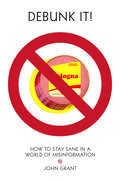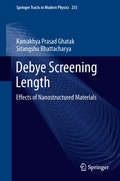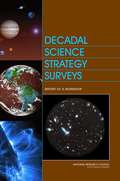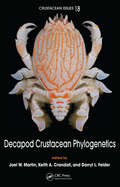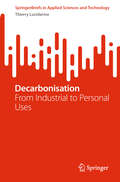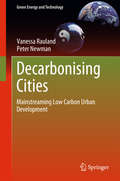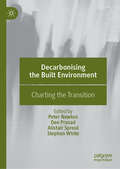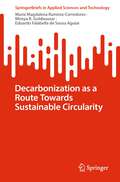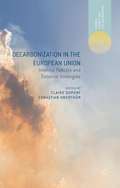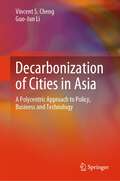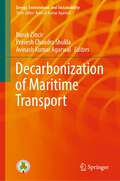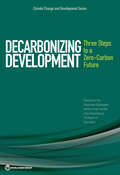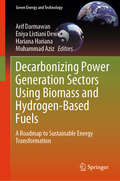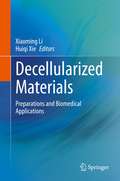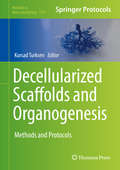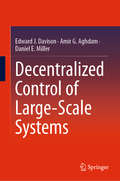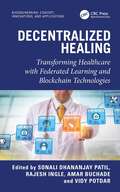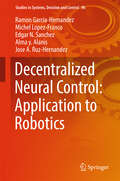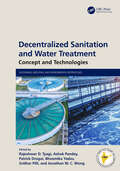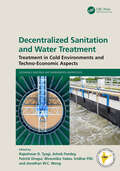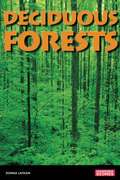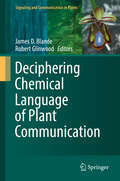- Table View
- List View
Debating the Faith: Religion and Letter Writing in Great Britain, 1550-1800
by Anne Dunan-Page Clotilde PrunierThe first book to address the role of correspondence in the study of religion, Debating the Faith: Religion and Letter Writing in Great Britain, 1550-1800 shows how letters shaped religious debate in early-modern and Enlightenment Britain, and discusses the materiality of the letters as well as questions of form and genre. Particular attention is paid to the contexts in which letters were composed, sent, read, distributed, and then destroyed, copied or printed, in periods of religious tolerance or persecution. The opening section, 'Protestant identities', examines the importance of letters in the shaping of British protestantism from the underground correspondence of Protestant martyrs in the reign of Mary I to dissident letters after the Act of Toleration. 'Representations of British Catholicism', explores the way English, Irish and Scottish Catholics, whether in exile or at home, defined their faith, established epistolary networks, and addressed political and religious allegiances in the face of adversity. The last part, 'Religion, science and philosophy', focuses on the religious content of correspondence between natural scientists and philosophers.
Debunk It!
by John GrantWe live in an era of misinformation, much of it spread by authority figures, including politicians, religious leaders, broadcasters, and, of course, apps and websites. With so much bogus information coming from so many sources, how can anyone be expected to discover the truth?In Debunk It, author John Grant uses modern, ripped-from-the-headlines examples to clearly explain how to identify bad evidence and poor arguments. He provides a roundup of the rhetorical tricks people use when attempting to pull the wool over our eyes, and even offers advice about how to take these unscrupulous pundits down. So if you're tired of hearing blowhards spouting off about climate change, history, evolution, medicine, and more, this is the book for you. Debunk It is the ultimate guide for young readers seeking a firmer footing in a world that's full of holes.
Debye Screening Length
by Kamakhya Prasad Ghatak Sitangshu BhattacharyaThis monograph solely investigates the Debye Screening Length (DSL) in semiconductors and their nano-structures. The materials considered are quantized structures of non-linear optical, III-V, II-VI, Ge, Te, Platinum Antimonide, stressed materials, Bismuth, GaP, Gallium Antimonide, II-V and Bismuth Telluride respectively. The DSL in opto-electronic materials and their quantum confined counterparts is studied in the presence of strong light waves and intense electric fields on the basis of newly formulated electron dispersion laws that control the studies of such quantum effect devices. The suggestions for the experimental determination of 2D and 3D DSL and the importance of measurement of band gap in optoelectronic materials under intense built-in electric field in nano devices and strong external photo excitation (for measuring photon induced physical properties) have also been discussed in this context. The influence of crossed electric and quantizing magnetic fields on the DSL and the DSL in heavily doped semiconductors and their nanostructures has been investigated. This monograph contains 150 open research problems which form the integral part of the text and are useful for both PhD students and researchers in the fields of solid-state sciences, materials science, nano-science and technology and allied fields in addition to the graduate courses in modern semiconductor nanostructures.
Decadal Science Strategy Surveys: Report Of A Workshop
by National Research Council of the National AcademiesThe National Academies Press (NAP)--publisher for the National Academies--publishes more than 200 books a year offering the most authoritative views, definitive information, and groundbreaking recommendations on a wide range of topics in science, engineering, and health. Our books are unique in that they are authored by the nation's leading experts in every scientific field.
Decapod Crustacean Phylogenetics (Advances in Crustacean Research)
by Joel W. Martin Keith A. Crandall Darryl L. FelderDecapod crustaceans are of tremendous interest and importance evolutionarily, ecologically, and economically. There is no shortage of publications reflecting the wide variety of ideas and hypotheses concerning decapod phylogeny, but until recently, the world's leading decapodologists had never assembled to elucidate and discuss relationships among
Decarbonisation: From Industrial to Personal Uses (SpringerBriefs in Applied Sciences and Technology)
by Thierry LucidarmeThis book is an insightful introduction to the pressing issues surrounding the climate emergency. The book proposes a set of principles of action, which prioritize technological solutions classified in descending order of carbon density. The book highlights the urgent need to decarbonize industrial sites, as they are the primary sources of carbon emissions. It presents a rational approach to limiting emissions by improving the operational efficiency of industrial processes, electrification, and substitution of fossil fuels with carbon-free energy vectors such as hydrogen or ammonia. The book also describes processes for carbon capture, sequestration in the subsoil, and recovery through industrial products. To demonstrate the application of these principles in difficult-to-decarbonize industrial segments, the book uses the industrial transport industry as an example. It also addresses the decarbonization of individual uses, such as electric cars for individual transport and heat pumps for individual heating. The book concludes by discussing the capture of carbon directly from the atmosphere. It presents a comprehensive view of decarbonization technology, providing readers with a clear understanding of the technological basis required to develop any decarbonization roadmap. The book takes a scientific and engineering approach, trying to avoid any ideological or apocalyptic stance sometimes associated with the topic. The reader is left with a logical and realistic perspective of decarbonization, taking into account scientific and economic logic and orders of magnitude.
Decarbonising Cities
by Peter Newman Vanessa RaulandThis book sets out some positive directions to move forward including government policy and regulatory options, an innovative GRID (Greening, Regenerative, Improvement Districts) scheme that can assist with funding and management, and the first steps towards an innovative carbon credit scheme for the built environment. Decarbonising cities is a global agenda with huge significance for the future of urban civilisation. Global demonstrations have shown that technology and design issues are largely solved. However, the mainstreaming of low carbon urban development, particularly at the precinct scale, currently lacks sufficient: standards for measuring carbon covering operational, embodied and transport emissions; assessment and decision-making tools to assist in design options; certifying processes for carbon neutrality within the built environment; and accreditation processes for enabling carbon credits to be generated from precinct-wide urban development. Numerous barriers are currently hindering greater adoption of high performance, low carbon developments, many of which relate to implementation and governance. How to enable and manage precinct-scale renewables and other low carbon technologies within an urban setting is a particular challenge.
Decarbonising the Built Environment: Charting the Transition
by Stephen White Alistair Sproul Peter Newton Deo PrasadThis book focuses on the challenge that Australia faces in transitioning to renewable energy and regenerating its cities via a transformation of its built environment. Both are necessary conditions for low carbon living in the 21st century. This is a global challenge represented by the United Nation’s Sustainable Development Goals and the IPCC’s Climate Change program and its focus on mitigation and adaptation. All nations must make significant contributions to this transformation. This book highlights the new knowledge and innovation that has emerged from research projects undertaken in the Co-operative Research Centre for Low Carbon Living between 2012 and 2019 – an initiative of the Australian Government’s Department of Industry, Science and Technology that is tasked with responding to the UN challenges. Four principal transition pathways were central to the CRC and provide the thematic structure to this volume. They focus on technology, buildings, precinct and city design, and human behaviour – and their interactions.
Decarbonization as a Route Towards Sustainable Circularity (SpringerBriefs in Applied Sciences and Technology)
by Maria Magdalena Ramirez-Corredores Mireya R. Goldwasser Eduardo Falabella de Sousa AguiarThis book surveys the current research on CO2 conversion processes and shows that these can close the carbon cycle as part of a circular economy. The technical and economic feasibility of these processes are examined together and current scientific challenges are signposted, which will guide future R&D. Technology sustainability is key for meeting and keeping decarbonization goals in the long term. However, considering economic and environmental sustainability individually is not enough. An integral view of sustainability that incorporates an energy term in the equation is needed. This book brings this concept to the fore.
Decarbonization in the European Union
by Claire Dupont Sebastian Oberth�rIn October 2009, the European Union (EU) agreed to reduce greenhouse gas (GHG) emissions by between 80 and 95 per cent by 2050 in the EU as a whole, as compared to 1990 levels – an objective that is in line with scientific calls to ensure we have a chance of limiting global temperature increase to 2#65533;Celsius. With the EU's energy sector required to almost completely decarbonise by 2050 (meaning almost zero GHG emissions from energy production, transportation and consumption), a major transition in just a few decades is necessary to achieve this goal. Therefore, a long-term policy perspective towards 2050 is essential. Many decisions taken today influence the EU's ability to meet its decarbonisation goals. The authors investigate how far the EU is along the road to decarbonisation, and what remains to be done in policy development. They also seek to understand whether the decarbonisaton goal is a central feature of the EU's external relations with its energy partners, andhow these relations could change under decarbonisation.
Decarbonization of Cities in Asia: A Polycentric Approach to Policy, Business and Technology
by Vincent S. Cheng Guo-Jun LiThis book provides best practices for decarbonizing cities in East Asia, in which buildings are the major contributor to carbon emissions. Beyond the global commitment through the Paris Agreement to make collective efforts on climate action and accelerated policies, investment and development at the country and city level to combat climate change are occurring at an unprecedented rate. Rapid urbanization and increasing energy demand for large and dense Asian cities require smart and sustainable strategies to balance development with decarbonization. A poly-centric approach is needed, where a combination of policy-, market- and technology-driven changes can aid the transition towards development of carbon neutral cities. With practical examples in the implementation of the United Nations Sustainable Development Goals, green financing, climate action roadmap and policy, deployment of renewable energy, and low- to zero-carbon buildings, readers can find the motivation, considerations and implementation pathways to facilitate the transition into the new normal. It is the hope of the authors to encourage readers to see successful pathways in transitioning into a carbon-free industry and overcoming the effects of climate extremes.
Decarbonization of Maritime Transport (Energy, Environment, and Sustainability)
by Avinash Kumar Agarwal Pravesh Chandra Shukla Burak ZincirThis contributed book focuses on decarbonization of maritime transport by highlighting different aspects of decarbonization methods indicated in the International Maritime Organization’s Initial Greenhouse Gas Strategy (2018). The book contains studies on alternative fuels and alternative energy systems with their life cycle assessment, electrification and hybridization of ships, carbon capture technologies, green port concept, energy efficiency management, and market-based measures. This book will be of interest to those working in academia and industry in maritime technologies and transportation.
Decarbonization or Demise – Sustainable Solutions for Resilient Communities: Selected Papers from the International Conference of Sustainable Ecological Engineering Design for Society (SEEDS) 2023
by Beth Jones Mohammad Dastbaz Christopher Gorse Colin Booth Lloyd Scott Darryl Newport Saheed Ajayi Leonie ParkinsonThe International Conference for Sustainable Ecological Engineering Design for Society (SEEDS) brings together experts from around the world to focus on changes required to minimize the impact of human activity on the environment. The research presented at the conference directly addresses the imperatives faced in addressing the climate crisis, whether through technological transformation, community collaboration, or resource management – all vital issues when changing and challenging practices within our built environment. The SEEDS Conference is designed to share the knowledge and experience needed to implement research and evidence-based societal change to respond to and address ecological and climate impacts.
Decarbonizing Development
by Marianne Fay Adrien Vogt-Schilb Ulf Narloch Tom Kerr Stephane Hallegatte RozenbergThe science is unequivocal: stabilizing climate change implies bringing net carbon emissions to zero. This must be done by 2100 if we are to keep climate change anywhere near the 2oC warming that world leaders have set as the maximum acceptable limit. Decarbonizing Development: Three Steps to a Zero-Carbon Future looks at what it would take to decarbonize the world economy by 2100 in a way that is compatible with countries' broader development goals. Here is what needs to be done: -Act early with an eye on the end-goal. To best achieve a given reduction in emissions in 2030 depends on whether this is the final target or a step towards zero net emissions. -Go beyond prices with a policy package that triggers changes in investment patterns, technologies and behaviors. Carbon pricing is necessary for an efficient transition toward decarbonization. It is an efficient way to raise revenue, which can be used to support poverty reduction or reduce other taxes. Policymakers need to adopt measures that trigger the required changes in investment patterns, behaviors, and technologies - and if carbon pricing is temporarily impossible, use these measures as a substitute. -Mind the political economy and smooth the transition for those who stand to be most affected. Reforms live or die based on the political economy. A climate policy package must be attractive to a majority of voters and avoid impacts that appear unfair or are concentrated on a region, sector or community. Reforms have to smooth the transition for those who stand to be affected, by protecting vulnerable people but also sometimes compensating powerful lobbies.
Decarbonizing Power Generation Sectors Using Biomass and Hydrogen-Based Fuels: A Roadmap to Sustainable Energy Transformation (Green Energy and Technology)
by Muhammad Aziz Arif Darmawan Eniya Listiani Dewi Hariana HarianaThis book presents a comprehensive overview of important issues and topics concerning the combustion and cofiring of biomass and hydrogen-based fuels such as ammonia in the power generation sector. In recent years, the energy sector has been responsible for around three-quarters of global greenhouse gas (GHG) emissions. Cofiring of coal with agricultural and forestry wastes and low-emissions hydrogen and ammonia could reduce GHG emissions from power plants and may offer a cheaper option to achieve Net Zero Emissions (NZE). This book provides an updated review of combustion and co-combustion technologies, especially for ammonia and hydrogen cofiring, which includes technical issues, emission reduction, and by-product problems. It goes into an in-depth discussion of hydrogen and ammonia "exclusive" combustion for power generation to reduce CO2 emissions. The content caters to students, academic and industry researchers, and policymakers who are interested in decarbonizing power generation sectors using biomass and hydrogen-based fuels.
Decellularization Methods of Tissue and Whole Organ in Tissue Engineering (Advances in Experimental Medicine and Biology #1345)
by Abdol-Mohammad KajbafzadehThis contributed volume is the first of a series that introduces safe, feasible, and practical decellularization and recellularization techniques for tissue and organ reconstruction. We have put special emphasis on the research areas most likely to develop well-engineered scaffolds for tissue and organ engineering, while presenting easily applicable bench-to-bedside approaches highlighting the latest technical innovations in the field.This book includes both a fundamental discussion for a broad understanding of the basis of tissue repair and substitution, as well as chapters written by world renowned specialists from 20 countries providing deeper discussions and analysis of related sub disciplines.Within these pages, the reader will find state-of-the-art protocols and current clinical challenges in cell and tissue biology, including accurate and comprehensive information on extracellular matrices, natural biomaterials, tissue dynamics, morphogenesis, stem cells, cellular fate progressions, cell and tissue properties for in-vitro and in-vivo applications.This comprehensive and carefully organized treatise provides a clear framework for graduate students and postdoctoral researchers new to the field, but also for researchers and practitioners looking to expand their knowledge on tissue and organ reconstruction.
Decellularized Materials: Preparations and Biomedical Applications
by Xiaoming Li Huiqi XieThis book will consist of 8 chapters, in which important issues regarding decellularized materials (DMs) will be discussed. This book will provide special knowledge of materials for the persons with biomedical background, and special biomedical knowledge for the persons with the background of materials, which will hopefully become a valuable informative read for the researchers and students of biomedical engineering major.
Decellularized Scaffolds and Organogenesis: Methods and Protocols (Methods in Molecular Biology #1577)
by Kursad TurksenThis practical, hands-on volume examines the use of decellularized tissues and organs as biologically-active scaffolds by providing numerous approaches from experts in the field. While knowledge of how to grow and differentiate cells in culture has dramatically improved over time, the book addresses the challenges of how to instruct particular cells of interest to recognize and respond to their environment so as to proliferate, differentiate, and function for restoration of original tissue and organ form and function. Written for the highly successful Methods in Molecular Biology series, chapters include introductions to their respective topics, lists of the necessary materials and reagents, step-by-step, readily reproducible protocols, and tips on troubleshooting and avoiding known pitfalls.Authoritative and easy to use, Decellularized Scaffolds and Organogenesis: Methods and Protocols share novel approaches and insights that will provide new opportunities for those already in the field or moving to enter the field.
Decentralized Control of Large-Scale Systems
by Edward J. Davison Amir G. Aghdam Daniel E. MillerA large-scale system is composed of several interconnected subsystems. For such a system it is often desired to have some form of decentralization in the control structure, since it is typically not realistic to assume that all output measurements can be transmitted to every local control station. Problems of this kind can appear in electric power systems, communication networks, large space structures, robotic systems, economic systems, and traffic networks, to name only a few. Typical large-scale control systems have several local control stations which observe only local outputs and control only local inputs. All controllers are involved, however, in the control operation of the overall system. The focus of this book is on the efficient control of interconnected systems, and it presents systems analysis and controller synthesis techniques using a variety of methods. A systematic study of multi-input, multi-output systems is carried out and illustrative examples are given to clarify the ideas.
Decentralized Healing: Transforming Healthcare with Federated Learning and Blockchain Technologies (Bioengineering)
by Sonali Dhananjay Patil Rajesh Ingle Amar Buchade Vidy PotdarThe convergence of emerging technologies is reshaping industries at an unprecedented pace, and healthcare is no exception. With the rapid digitization of medical records, the proliferation of connected health devices, and the growing need for secure and efficient data management, the healthcare sector faces both immense opportunities and daunting challenges. Among the most promising solutions to these challenges are blockchain technology and federated learning—two revolutionary paradigms that offer a decentralized, privacy-preserving approach to healthcare innovation.Decentralized Healing: Transforming Healthcare with Federated Learning and Blockchain Technologies aims to serve as a comprehensive guide to understanding and implementing these transformative technologies in the healthcare ecosystem. The chapters in this book cover a diverse range of topics, from fundamental concepts and theoretical frameworks to real-world applications and case studies. Readers will gain insights into how federated learning enables collaborative artificial intelligence (AI) training while preserving patient data privacy, how blockchain ensures data integrity, security, and traceability, and how the integration of these technologies can drive innovations in electronic health records, cybersecurity, and decentralized healthcare networks. A major highlight of this book is its focus on practical applications and future trends. Whether you are a healthcare professional, blockchain/AI researcher, policymaker, or industry leader, it offers valuable knowledge and actionable insights into how decentralized approaches can empower patients, improve medical decision-making, and revolutionize global healthcare infrastructures.This book serves as a valuable resource for anyone passionate about the future of healthcare and technology. By embracing decentralized and privacy-preserving solutions, we can pave the way for a more secure, efficient, and patient-centric healthcare system.Let the journey towards decentralized healing begin!
Decentralized Neural Control: Application to Robotics
by Ramon Garcia-Hernandez Michel Lopez-Franco Edgar N. Sanchez Alma Y. Alanis Jose A. Ruz-HernandezThis book provides a decentralized approach for the identification and control of robotics systems. It also presents recent research in decentralized neural control and includes applications to robotics. Decentralized control is free from difficulties due to complexity in design, debugging, data gathering and storage requirements, making it preferable for interconnected systems. Furthermore, as opposed to the centralized approach, it can be implemented with parallel processors. This approach deals with four decentralized control schemes, which are able to identify the robot dynamics. The training of each neural network is performed on-line using an extended Kalman filter (EKF). The first indirect decentralized control scheme applies the discrete-time block control approach, to formulate a nonlinear sliding manifold. The second direct decentralized neural control scheme is based on the backstepping technique, approximated by a high order neural network. The third control scheme applies a decentralized neural inverse optimal control for stabilization. The fourth decentralized neural inverse optimal control is designed for trajectory tracking. This comprehensive work on decentralized control of robot manipulators and mobile robots is intended for professors, students and professionals wanting to understand and apply advanced knowledge in their field of work.
Decentralized Sanitation and Water Treatment: Concept and Technologies (Sustainable Industrial and Environmental Bioprocesses)
by Ashok Pandey Patrick Drogui Bhoomika Yadav Sridhar Pilli Rajeshwar D. Tyagi Wong, Jonathan W.C.This book provides up-to-date information on the concepts and technologies in decentralized sanitation for wastewater treatment and management. It addresses the knowledge gap that exists between the understanding of centralized and decentralized wastewater treatment approaches. Decentralized Sanitation and Water Treatment: Concept and Technologies covers the sustainability principles and technologies involved, and common decentralized treatment and disposal methods. It includes topics like septage as a resource, resource recovery, anaerobic treatment of domestic sewage, and decentralized sanitation in various countries.Features Provides case studies from all around the world to explain the traditional and advanced technologies in decentralized sanitation and wastewater treatment Discusses real examples and cases from rural, urban, and peri-urban areas Focuses on interdisciplinary approaches of sustainability and circular economies Covers topics like water recycling, resource recovery, and use of sustainable energy sources Reviews common treatments and disposal methods of decentralized sanitation The book is meant for professionals and researchers working on wastewater treatment, environmental engineering, and ecology.
Decentralized Sanitation and Water Treatment: Treatment in Cold Environments and Techno-Economic Aspects (Sustainable Industrial and Environmental Bioprocesses)
by Ashok Pandey Rajeshwar D Tyagi Patrick Drogui Bhoomika Yadav Sridhar Pilli Wong, Jonathan W.C.This book discusses decentralized sanitation for wastewater treatment and management in cold environments. It addresses the knowledge gap that exists between the understanding of centralized and decentralized wastewater treatment approaches. Decentralized Sanitation and Water Treatment: Treatment in Cold Environments and Techno-Economic Aspects covers the sustainability principles, various technologies involved, decentralized treatment in cold countries, and the economic and social feasibility of decentralized sanitation. It provides solutions for the conservation of water sources and target-oriented sanitation approaches for wastewater treatment and recycling.Key Features Reviews the current status, challenges, and future perspectives of decentralized water treatments Discusses decentralized sanitation, water, and wastewater treatment in cold environments and Northern countries Focuses on interdisciplinary approaches of sustainability and circular economy Covers life cycle and environment assessment of decentralized sanitation systems Reviews the environmental, techno-economic, and social aspects of decentralized sanitation systems The book is meant for professionals and researchers working on wastewater treatment, environmental engineering, and ecology.
Deciduous Forests
by Donna LathamInvestigating the planet's biomes and examining the modern threats to each ecosystem, this interactive series challenges young readers to look at how their own actions influence the planet's health. With compare-and-contrast facts and vocabulary-building sidebars, each engaging guide reveals how environmental threats-both human and natural-affect plants and animals.Showcasing the diverse woodland of deciduous forests, this resource reveals how many of its threats come from humans. Covering topics such as deforestation, acid rain, disease, and invasive species, this engaging guide shows how, in the complicated web of life in the forest, even natural threats can be made worse by human activity.
Deciphering Chemical Language of Plant Communication
by James D. Blande Robert GlinwoodThis book provides an overviewof the intricacies of plant communication via volatile chemicals. Plantsproduce an extraordinarily vast array of chemicals, which provide communitymembers with detailed information about the producer's identity, physiology andphenology. Volatile organic chemicals, either as individual compounds or complexchemical blends, are a communication medium operating between plants and anyorganism able to detect the compounds and respond. The ecological andevolutionary origins of particular interactions between plants and the greatercommunity have been, and will continue to be, strenuously debated. However, itis clear that chemicals, and particularly volatile chemicals, constitute amedium akin to a linguistic tool. As well as possessing a rich chemicalvocabulary, plants are known to detect and respond to chemical cues. These cues can originate from neighbouring plants, or other associatedcommunity members. This book begins with chapters on the complexity of chemicalmessages, provides a broad perspective on a range of ecological interactionsmediated by volatile chemicals, and extends to cutting edge developments on thedetection of chemicals by plants.

